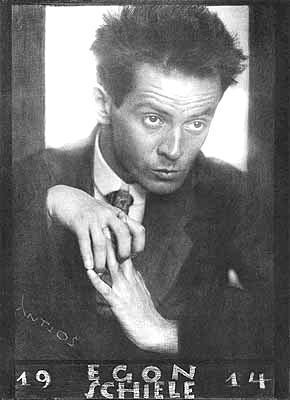(Tully, 1890- Vienna, 1918)
Egon Schiele was born in Tully on June 12, 1890. In 1905, his father died, and he was sent to live with his uncle, who soon discovered his artistic talent. He studied drawing and design at the Academy of Fine Arts in Vienna. Frustrated by the conservative environment, in 1909, he founded the Neukunstgruppe and met Klimt. For Schiele, Klimt was a master and a model of admiration. For Klimt, Schiele was like a friend.
In 1908, Schiele held his first exhibition, which was received with great success.
In Schiele, his rigorous rejection of schematization and the smooth, uncommitted style manifested itself early on. As a consequence, everything expressive was accentuated unrestrainedly.
In 1911, he began a romantic relationship with 17-year-old Valerie (Wally) Neuzil. Together they moved to Krumau (the village of his mother) until the scandal erupted: he was accused of corruption of minors. Schiele often used children who came to his house as models, frequently depicting them naked or in obscene positions. Hence, his works were labeled as pornographic.
After a brief stay in jail, Schiele returned to Vienna. Thanks to his friend Klimt, he received numerous commissions and returned to the top of the Austrian art scene, participating in many international exhibitions.
He met Edith and Adele Harms, two bourgeois sisters, and after courting them, he married Edith in 1914. The marriage provided him stability and a resurgence of new pictorial strength influenced by the work of painter Ferdinand Hodler. In 1918, he successfully participated in the forty-ninth exhibition of the Vienna Secession, as well as other exhibitions in Zurich, Prague, and Dresden. In the autumn of 1918, the Spanish flu epidemic ravaged Vienna. Edith, six months pregnant, died. Three days later, on October 31, 1918, Egon Schiele died at the young age of 28.
The paintings of Egon Schiele show the torment of the solitary, the need for the faces of the afflicted, the pain and despair of the suffering, as well as the desolation of the helpless. However, Schiele was also able to elevate subjective aspects to general validity. In him, autumn transforms into a symbol of the perishable in men and things. Not only living matter but also inanimate nature is endowed with spirit.
Both in Schiele's figure compositions and in landscapes with trees and houses, not to mention his city paintings, the form of presentation is replaced by an extremely unusual form of experience; moods and feelings transform into visionary dioramas of global human transcendence that speak directly to the viewer.
Schiele manages to give new content to the most unusual. He was an important colorist, a painter, and an artist of painting.
Egon Schiele was born in Tully on June 12, 1890. In 1905, his father died, and he was sent to live with his uncle, who soon discovered his artistic talent. He studied drawing and design at the Academy of Fine Arts in Vienna. Frustrated by the conservative environment, in 1909, he founded the Neukunstgruppe and met Klimt. For Schiele, Klimt was a master and a model of admiration. For Klimt, Schiele was like a friend.
In 1908, Schiele held his first exhibition, which was received with great success.
In Schiele, his rigorous rejection of schematization and the smooth, uncommitted style manifested itself early on. As a consequence, everything expressive was accentuated unrestrainedly.
In 1911, he began a romantic relationship with 17-year-old Valerie (Wally) Neuzil. Together they moved to Krumau (the village of his mother) until the scandal erupted: he was accused of corruption of minors. Schiele often used children who came to his house as models, frequently depicting them naked or in obscene positions. Hence, his works were labeled as pornographic.
After a brief stay in jail, Schiele returned to Vienna. Thanks to his friend Klimt, he received numerous commissions and returned to the top of the Austrian art scene, participating in many international exhibitions.
He met Edith and Adele Harms, two bourgeois sisters, and after courting them, he married Edith in 1914. The marriage provided him stability and a resurgence of new pictorial strength influenced by the work of painter Ferdinand Hodler. In 1918, he successfully participated in the forty-ninth exhibition of the Vienna Secession, as well as other exhibitions in Zurich, Prague, and Dresden. In the autumn of 1918, the Spanish flu epidemic ravaged Vienna. Edith, six months pregnant, died. Three days later, on October 31, 1918, Egon Schiele died at the young age of 28.
The paintings of Egon Schiele show the torment of the solitary, the need for the faces of the afflicted, the pain and despair of the suffering, as well as the desolation of the helpless. However, Schiele was also able to elevate subjective aspects to general validity. In him, autumn transforms into a symbol of the perishable in men and things. Not only living matter but also inanimate nature is endowed with spirit.
Both in Schiele's figure compositions and in landscapes with trees and houses, not to mention his city paintings, the form of presentation is replaced by an extremely unusual form of experience; moods and feelings transform into visionary dioramas of global human transcendence that speak directly to the viewer.
Schiele manages to give new content to the most unusual. He was an important colorist, a painter, and an artist of painting.


